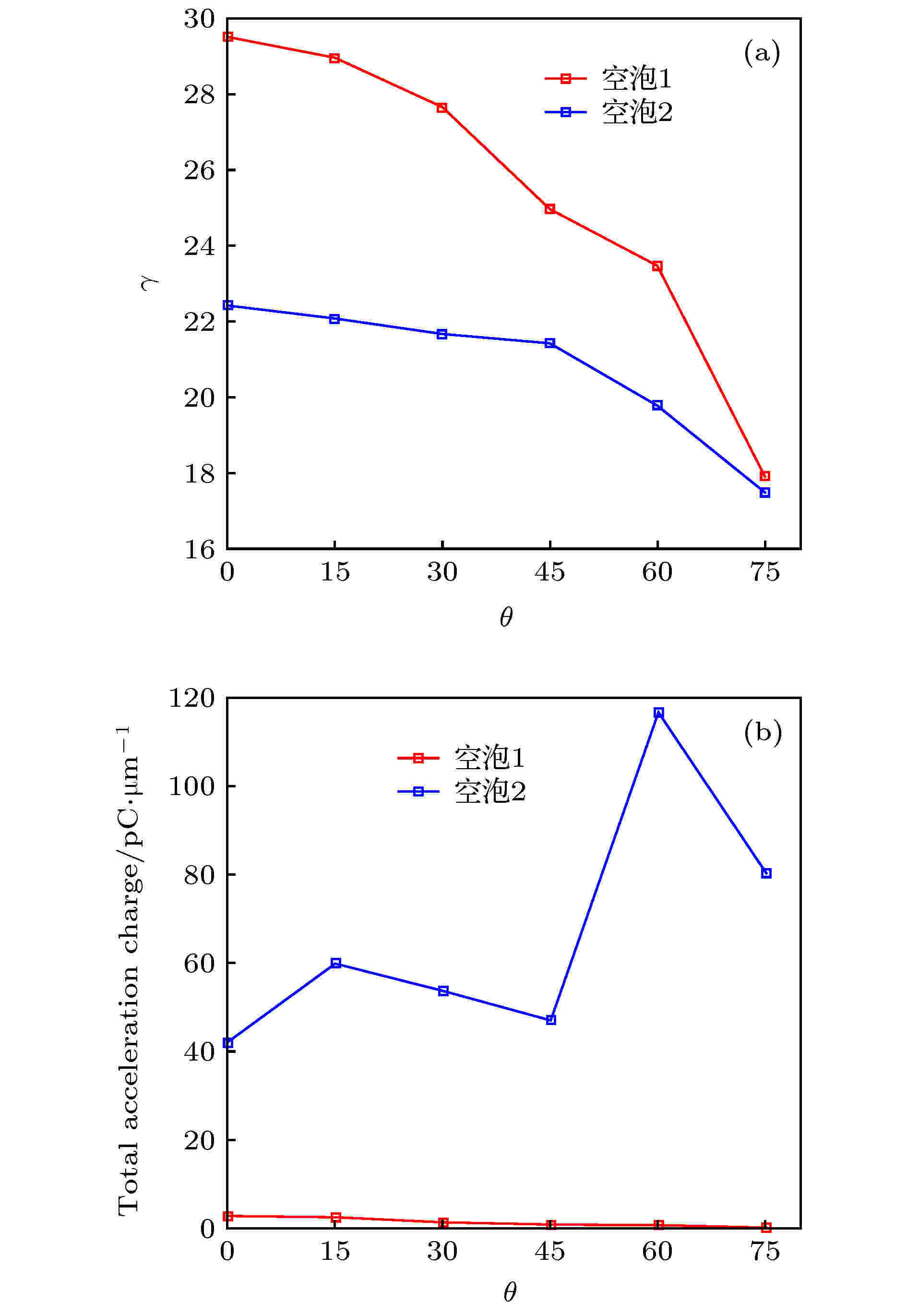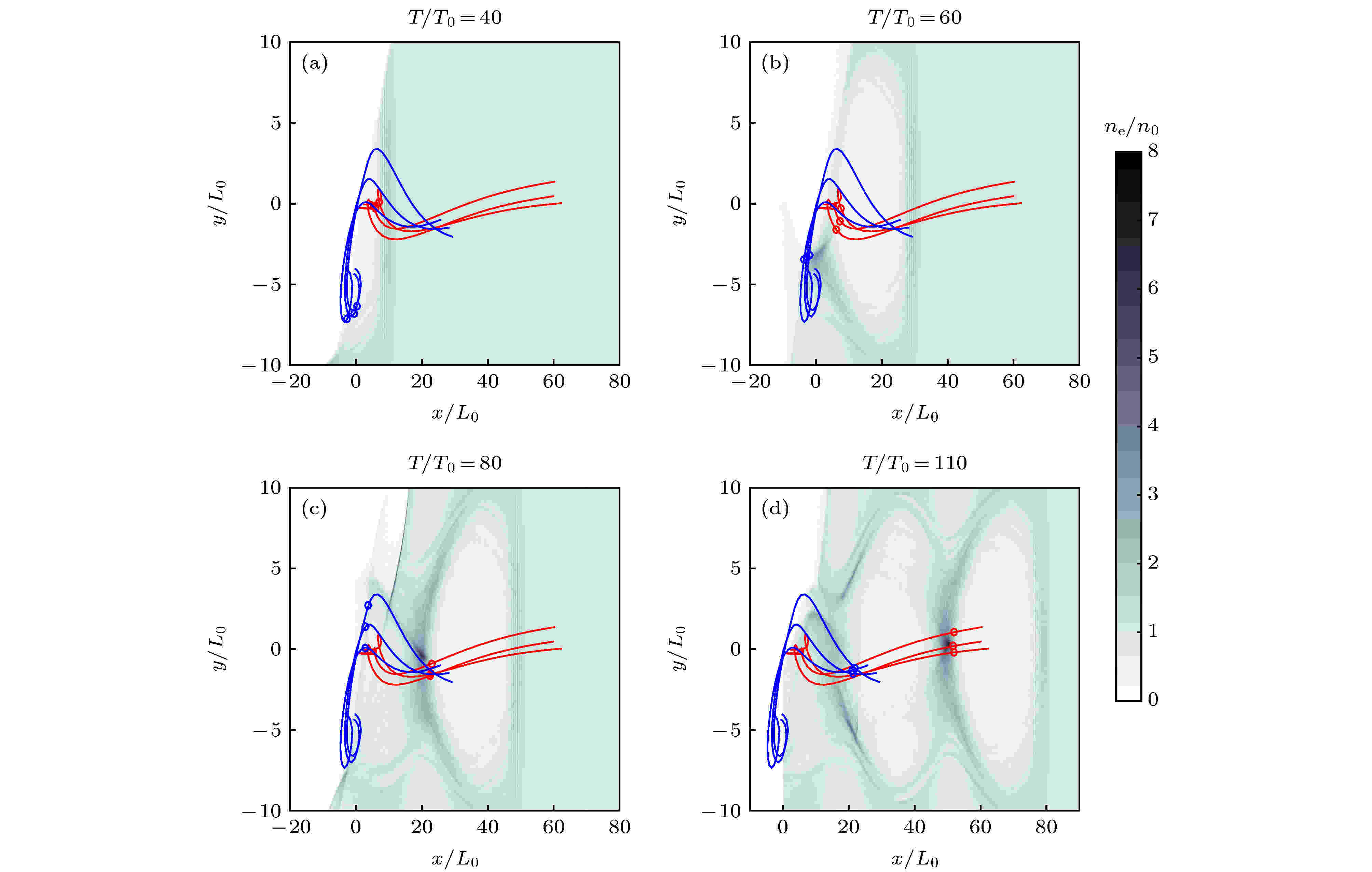全文HTML
--> --> -->在激光尾波加速中, 根据对输出电子束品质, 如电量、能散、发射度等要求的不同, 需要有效的控制电子注入的方式. 其中尾波波破自注入是最基本和最早被研究的注入方式, 如今已经发展出来多种控制注入的手段, 如密度梯度注入[7,8]、对撞光碰撞注入[9]和离化注入[10-16]等. 除此之外, 另一种行之有效的注入方法是如图1所示的利用特殊的超音速喷嘴, 实现锐的真空-等离子体边界, 在分界面处产生由于密度突变造成的边界注入[17]. 在锐的真空-等离子体边界处, 电子可以被激光场排出原来所处的等离子体区域, 在边界处形成电子薄层, 该薄层与激光后沿尾波处的背景离子形成电荷分离场, 一些从真空返回等离子体区域的电子会被该静电分离场注入到空泡中, 在空泡的尾部集聚, 形成一个被捕获并加速的致密电子束团.
 图 1 真空等离子体边界激光尾波电子注入示意图
图 1 真空等离子体边界激光尾波电子注入示意图Figure1. Schematic of vacuum-plasma boundary injection in laser wakefield acceleration
在尾波中, 注入电子除了通常的纵向加速外, 当电子在尾波中有初始横向动量或横向位置偏移时, 会在尾波横向场的约束力下做横向周期性振荡, 发出频段为X射线的Betatron辐射[18]. 为了利用激光尾波的Betatron辐射, 除了对电子进行纵向高能加速外, 人们还希望对注入电子的横向位置和动量加以控制[19], 以得到品质更好的辐射源. 而上述发生在倾斜边界处的电子注入, 有望对该横向注入位置和动量予以控制.
采用二维粒子模拟(2D-PIC)程序OSIRIS[20]研究倾斜边界对电子注入和最终束品质产生的影响. 在模拟中使用归一化的单位, 长度归一化到等离子体波长尺度L0 = c/ωp, 其中ωp = 2πc/λp为等离子体频率, c是真空中的光速. 时间归一化到等离子体周期尺度

本文将对该边界注入机制开展数值模拟研究, 以进一步获得对该机制的清晰理解, 并且根据模拟结果, 得到注入电子束品质(能散、电量和横向动量)对边界倾角和激光偏振方向的依赖关系, 为产生基于尾场的辐射源提供参考.
3.1.倾斜角对注入电量与能量的影响
首先研究真空等离子体边界面倾角对注入电量和最终电子能量的影响. 如图2(a)所示, 数值模拟研究表明, 在锐真空-等离子体边界注入下, 通常电子会被注入到第一和第二个尾波中. 为了研究倾斜角的影响, 分别对注入到不同空泡的电子进行统计, 如图2(b)所示, 对第二个空泡中的超粒子, 统计它们的电量、动量和能量, 并随机选取其中的100个计算它们的轨迹. 图 2 倾斜角为0°时激光传播500T0后等离子体密度与注入电子(γ ≥ 15)的位置分布 (a)注入电子的分布; (b)放大后第二个空泡中的电子分布
图 2 倾斜角为0°时激光传播500T0后等离子体密度与注入电子(γ ≥ 15)的位置分布 (a)注入电子的分布; (b)放大后第二个空泡中的电子分布Figure2. Distributions of plasma density and injected electrons after 500T0 propagation when the boundary slant angle is 0°: (a) Injected electrons; (b) electrons in the second bubble
分别对0—500T0时间范围内不同倾斜角度情况下两个空泡中被加速电子进行统计, 在它们的相对论因子大于等于15时计入统计, 如图3所示. 从图3可以看出, 不同倾斜角度对应的激光电子加速到统计阈值(γ ≥ 15)所需的时长是不一样的. 简而言之, 倾斜角越大时, 激光后沿的尾波形成时间越晚, 电子越晚被捕获; 而低倾斜角情况下, 尾波形成较早, 电子被捕获时间也相对更早, 从而加速启动的更早.
 图 3 激光传播过程中不同角度下的电子平均能量增长的情况 (a)第一个空泡内电子平均相对论因子γ的变化; (b) 第二个空泡内电子平均相对论因子γ的变化
图 3 激光传播过程中不同角度下的电子平均能量增长的情况 (a)第一个空泡内电子平均相对论因子γ的变化; (b) 第二个空泡内电子平均相对论因子γ的变化Figure3. Average energy growth with time: (a) Average gamma factor of electrons in the first bubble; (b) average gamma factor of electrons in the second bubble
如图3所示, 虽然不同边界倾斜角度下的电子加速启动时间不同, 但到达统计能量阈值后的加速梯度则差别较小. 这是因为形成了尾波结构后, 电子在等离子体中的加速就与边界条件无关, 仅与当地尾波场强度和其在尾场中所处的相位有关. 换言之, 仅与此时的激光强度和等离子体密度有关(此时电子基本都处在尾波的末尾处, 所以电子在尾波中的相位差别不大). 由此可见, 为了合理比较不同倾斜角度下被加速电子的能量和电量, 应比较经过相同加速距离后电子的平均能量与电量, 而不是固定在某一个加速位置处比较这些信息.
图4对比了不同倾斜角度下注入电子经过相同加速距离(1 mm)后的平均能量和注入电量. 从图4(a)可以看出, 当倾斜角提升时, 第一个空泡与第二个空泡的电子的平均能量均有所下降, 在大倾斜角度下, 两个空泡的电子的平均能量则趋于相同. 一般而言, 因为第一个空泡电子的产生时间更早, 加速时间更长, 其相较于第二个空泡电子的平均能量也要更高. 而且由于第一个空泡加速电子束自身激发的尾场与激光尾场相位相反, 往往会造成后面的尾场强度小于第一个加速节处的尾场, 所以通常第二个加速空泡中电子的能量要小于第一个空泡. 而在当前的情形下, 则有所不同, 随着入射角的增大, 两个空泡之间加速电子平均能量的差别则渐趋于无. 这是因为此时激光碰撞一侧的时间比激光碰撞中心的时间要更早, 第一个空泡的电子虽然更早进入空泡受到尾波场加速, 但是注入第二个空泡的电子在注入前就已经从电荷分离场中获得了一些能量, 它的起始注入能量比第一个空泡电子要更高.
 图 4 不同角度下电子注入后经过相同加速距离后的加速情况对比 (a)被加速电子的平均能量; (b)被加速电子的总电量(单位归一化到 pC/μm)
图 4 不同角度下电子注入后经过相同加速距离后的加速情况对比 (a)被加速电子的平均能量; (b)被加速电子的总电量(单位归一化到 pC/μm)Figure4. Electrons statistics after same acceleration length: (a) Average energy; (b) total acceleration charge (normalized to pC/μm).
图4(b)将不同倾斜角度下两个空泡内电子的电量进行比较, 在锐边界注入情形下, 第一个空泡的注入电量比第二个空泡少很多, 这种差异在倾斜角达到60°时最大, 此时第二个空泡的注入电子电量达到最高, 而第一空泡内电子注入量趋于0. 模拟中发现两个空泡中电子的平均能量其实相差并不是很大(见图4(a)), 所以最终加速电子束的总能量(以及激光到被加速电子的转换效率)依赖于被加速的电量, 它成为衡量加速效率的重要指标. 故对于锐边界注入, 具有较大注入电量的第二个空泡的电子会更适合应用, 这一点值得在应用研究中予以重点考虑.
2
3.2.倾斜角对注入电子横向振荡的影响
除了关注加速电量外, 被加速电子束的横向振荡对于电子束的Betatron辐射也是非常重要的, 直接关系到辐射的强度和辐射谱分布. 为了明确倾斜边界对电子横向运动产生的影响, 研究了被加速电子的运动轨迹. 对两个特定的倾斜角度(0°和45°), 在不同的空泡中各选取100个被加速电子, 根据它们的轨迹分析注入特征.如图5(a)所示, 在锐的倾斜情形中(0°), 注入电子沿着激光传输方向是基本对称的; 在边界倾斜角为45°时, 如图5(b)所示, 产生的注入电子则具有上下非对称性. 注入电子的这种上下轨迹不对称性是斜入射与0°入射激光的主要不同之处. 在边界面与入射光非垂直的情况下, 可以预见到激光单侧将与等离子体优先接触, 另一侧的接触时间则相对滞后, 此时仅有最先接触的那一侧附近的电子能够发生注入. 这种机制是导致二者的加速电子在统计上轨迹不同的原因, 同时也会导致电子在加速过程中横向振荡的不同.
 图 5 不同倾斜角度下的第一个空泡(红色)和第二个空泡(蓝色)中注入电子的轨迹(为了显示清晰, 对两种倾角情形, 各自只选取了10个典型的电子) (a) 0°; (b) 45°
图 5 不同倾斜角度下的第一个空泡(红色)和第二个空泡(蓝色)中注入电子的轨迹(为了显示清晰, 对两种倾角情形, 各自只选取了10个典型的电子) (a) 0°; (b) 45°Figure5. Trajectories of electrons in the first bubble (red) and second bubble (blue): (a) 0°; (b) 45°. Ten electrons’ trajectories have been selected for clearer view
图6显示了所有高能电子的横向动量的统计结果, 对于0°和45°的两种边界下, 空泡中被加速电子的横向振荡过程存在差异. 0°边界倾角时, 第一个空泡内注入电子的横向动量较小, 而第二个空泡内注入电子的横向动量则沿入射光两侧对称振荡, 幅度与45°倾角边界注入时类似, 但该倾角下第一个空泡内电子的振荡幅度也得到了增强(这是由于第一个空泡内电子注入较早, 但注入时空泡形成具有不对称性, 电子获得初始横向动量较大), 有利于强的Betatron辐射. 通常大的横向振荡幅度有望提升小型化台面X射线辐射源的强度和辐射谱的中心频率.
 图 6 (a) 0°倾斜边界角时注入空泡1 (红)和空泡2上下两侧注入电子(蓝)的平均动量; (b) 45°倾斜边界角时注入空泡1和空泡2电子的平均动量
图 6 (a) 0°倾斜边界角时注入空泡1 (红)和空泡2上下两侧注入电子(蓝)的平均动量; (b) 45°倾斜边界角时注入空泡1和空泡2电子的平均动量Figure6. (a) Average transverse momentum of electrons in the first bubble (red) and second bubble (blue) when the boundary slant angle is 0°; (b) average transverse momentum of electrons in the first bubble (red) and second bubble (blue) when the boundary slant angle is 45°
2
3.3.激光偏振方向对注入电子的影响
激光的电场方向对边界面注入过程也有一定的影响. 在二维模拟中, 当激光偏振方向与模拟平面垂直时(S偏振), 电子受到的激光作用仅表现为有质动力的作用而被光场排开; 而当激光偏振方向与模拟平面平行时(P偏振), 电子将在受到有质动力作用的同时也受到了激光电场的直接作用. 这种机制在激光斜入射高密度等离子体靶时会产生至关重要的作用[25]: 电子在由真空拉回到等离子体的过程中时, 将会与入射和反射的激光相互碰撞, 部分电子会被激光在真空中直接加速. 在尾波加速的等离子体密度区间, 激光虽然不能被等离子所完全反射, 但是由激光前沿排开的电子在回流注入时也可能会与尾部的激光发生相互作用, 从而对注入产生影响.基于此, 比较了45°边界下, S偏振和P偏振入射激光导致的尾场中注入电子的电量、横向振荡和能谱. 电量上, 如表1所列. 在第一个空泡中, P偏振入射激光注入电子比S偏振入射激光注入电子电量高三倍左右, 而第二个空泡中, 二者则相差甚小. 这证明了在斜入射机制下, 只有第一个空泡中的电子受到了类似Brunel过程[26]中的激光电场的直接作用. 而在第二个空泡内的电子在注入过程中, 仅受到了激光场平均下来的有质动力和静电分离场的影响, 因此对驱动激光偏振依赖度不大.
| 电量/pC·μm–1 | S偏振 | P偏振 |
| 第一个空泡 | 1.24 | 3.88 |
| 第二个空泡 | 47.21 | 47.00 |
表1S偏振和P偏振激光45°入射时注入空泡中的电子电量
Table1.Injection charge of S-polarization and P-polarization incidence at 45°.
同时还比较了S偏振和P偏振在45°倾斜边界下注入电子的能谱分布. 发现P偏振注入电子的能谱谱宽相对较小, 相较于S偏振入射注入电子束团的能散更低, 但两者中心能量差不多. 这可能是由于P偏振第一个空泡中注入的电子稍多造成的. 从整体来看, 在这样的激光参数下, 注入以第二个空泡为主, 所以激光偏振效应对电子束的能谱和能量差别不大.
 图 7 倾斜边界角为0°时的电子注入过程(等横向间距选取了3个粒子作为示意, 背景为等离子体密度, 线条代表粒子的真实轨迹, 圆圈代表粒子在该时刻的位置) (a) T/T0 = 20; (b) T/T0 = 40; (c) T/T0 = 60; (d) T/T0 = 90
图 7 倾斜边界角为0°时的电子注入过程(等横向间距选取了3个粒子作为示意, 背景为等离子体密度, 线条代表粒子的真实轨迹, 圆圈代表粒子在该时刻的位置) (a) T/T0 = 20; (b) T/T0 = 40; (c) T/T0 = 60; (d) T/T0 = 90Figure7. Electrons’ injection trajectories when the boundary slant angle is 0°: (a) T/T0 = 20; (b) T/T0 = 40; (c) T/T0 = 60; (d) T/T0 = 90. Here the background color bar represents the plasma density, we have selected 3 particles with equally separation along the transverse direction. The blue and red lines represent the injection trajectories and the circles represent the particles’ positions at that time
第二次注入的电子先是被激光的有质动力和空泡前部正向电荷场作用进入真空区域, 而后受到静电分离场的吸引回溯, 并进入第二个空泡的负向电场区域被捕获加速. 0°边界倾斜角情况下这些电子基本位于激光两侧, 模拟中观察到少量电子(7%)于中心被拖曳向外经历回旋过程也进入第二个空泡, 而这一情况在非0°边界倾斜角情况下则仅局限于单侧(如图8所示). 在被捕获过程中, 第二次电子注入的允许范围较第一次注入范围更大. 相比较而言, 第一次注入发生的空间范围小, 被注入到第一个空泡的电子电量也就比注入到第二个空泡的电子电量少很多. 同时, 边界越倾斜, 激光与等离子体边界相互作用的时间也就越长, 被扰动进真空的电子也就越多, 这样第二次注入的所允许的起始范围就更大, 造成了最终被加速电子电量的不同.
 图 8 45°入射下边界面产生电子注入的过程 (a) T/T0 = 40; (b) T/T0 = 60; (c) T/T0 = 80; (d) T/T0 = 110
图 8 45°入射下边界面产生电子注入的过程 (a) T/T0 = 40; (b) T/T0 = 60; (c) T/T0 = 80; (d) T/T0 = 110Figure8. Electrons injection at 45° incidence: (a) T/T0 = 40; (b) T/T0 = 60; (c) T/T0 = 80; (d) T/T0 = 110
横向振荡幅度的差异来自于电子注入时起始位置的不同(如图9所示); 0°入射第一次注入的位置在激光传播的中轴线方向, 而第二次注入的电子起始位置对称地处在激光的两侧, 上下两侧电子的横向振荡幅度相同, 方向相反. 当真空等离子体边界面变为倾斜, 原本对称地处在激光两侧位置的注入电子区域仅保留了其中较早与激光碰撞的一侧, 横向振荡仅源于单侧的电子, 相较于0°入射产生的注入, 其注入位置的纵向长度有所增加.
 图 9 (a)倾斜边界为0°情况下第一个空泡和第二个空泡内注入电子的起始位置; (b) 倾斜边界为45°入射下第一个空泡和第二个空泡内注入电子的起始位置
图 9 (a)倾斜边界为0°情况下第一个空泡和第二个空泡内注入电子的起始位置; (b) 倾斜边界为45°入射下第一个空泡和第二个空泡内注入电子的起始位置Figure9. (a) Original positions of the trapped electrons when the boundary slant angle is 0°; (b) original positions of the trapped electrons when the boundary slant angle is 45°
